Article
Petersburg: Alaska's "Little Norway"
Author(s):
In the second in a series on the many wonders of small ship cruising through South East Alaska, our travel columnists visit Petersburg, Alaska's "Little Norway."
In the second in a series on small ship cruising, our travel columnists visit Petersburg, Alaska's "Little Norway." Photography by the authors.

The children are striking: tall, blue-eyed, blond — and with apple cheeks. The former characteristics are due to their Norwegian heritage; the rosy cheeks the result of the wet, cold weather.
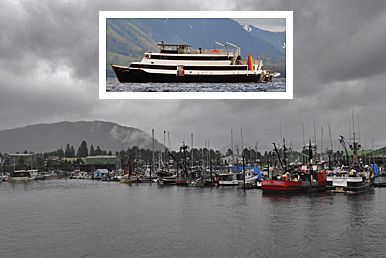
An engineer standing on the Petersburg harbormaster’s deck tells us he had 46 consecutive days of rain last year, then catching the Scottish accent one of us has, he smiles and adds, “It was just like a Scottish summer!’

We walk around the harbor. This is not Newport Beach, R.I. It’s surely not even our San Diego. There are working ships that sport battered prows and hulls that have seen better days, but this is an Alaskan fishing village. The decks, however, are ship-shape and gleam in the Northern dusk, because this is not a place to put to sea in ships that are ill-prepared for the Alaskan dawn.

The Fisherman’s Memorial Park down Sing Lee Alley beside the Sons of Norway hall bears proof of the dangers of the sea. The names are distributed in random fashion along the fence that surrounds the park. Four are grouped in our photograph because two are physicians and two seem particularly poignant.

A statue of a present-day fisherman stands beside a Viking boat as if to demonstrate that both groups share a common legacy. Indeed Vikings lived and often died on the seas. The boat is named Valhalla.

It’s a replica of an original Viking boat, built in 1976 to commemorate our nation’s Bicentennial. It has actually sailed, says Alaskan historian, Ed Readicker-Henderson, but if you look at it “you’ll wonder what kind of nuts the Vikings were, going out to sea in boats like that.”
Well, Peter Buschmann, the Norwegian who came here in 1896 surely wasn’t a nut. He was a shrewd, hard-working immigrant who immediately saw the combined potential of seas full of fish and a glacier next door to provide limitless ice. He built a cannery. Within four years he employed 150 people and by 1905 two more canneries were operating at full capacity. In 1938 the town had Alaska’s only traffic light! Petersburg has continued to prosper despite the drop-off in the fishing and lumber industries elsewhere in Alaska. Petersburg still has the largest fishing fleet in the South East, but not much tourism as larger cruise ships choose not to risk passing through the Wrangler Narrows to get to the town.

Although Petersburg has only 3,000 residents it buzzes as an active community. Many of the shops are bedecked with a decorative painting called rosemaling that makes the streets so colorful.
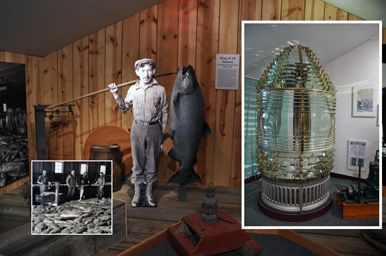
Five minutes walk from the harbor brings visitors to the little Clausen Memorial Museum with, for example, its photograph “Packing king salmon at the Winter-Pond Co” prominent on the wall beside a representation of the world record king salmon catch of 126.5 lbs. The museum’s other diverse offerings range from an informative video describing Petersburg’s history, historical photographs and examples of old fishing equipment to coastal native art, and native antique halibut hooks, fish clubs and harpoons. Those surely contrast with the colorful Norwegian costumes the locals wear on special occasions.
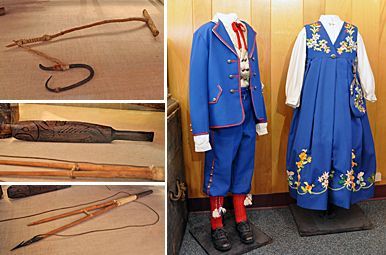
The residents seemingly know who has Norwegian blood. They can readily identify who is, say, fully Norwegian, half-Norwegian or even a quarter. The highlights for many are the special festivities relevant to the land they came from and May 17, for example, is Norwegian Independence Day. Jeff Behrens, the captain and owner of our small ship, Island Spirit had kindly arranged for local children to entertain his passengers with dinner, song and dance at the Sons of Norway Hall, a delightful end to a night in South East Alaska.
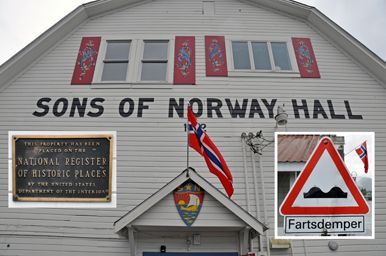
An unusual shore excursion 37 miles from Petersburg took us to Five Finger Lighthouse, the last manned lighthouse in the state. The first lighthouse burned in 1932, one of the first two commissioned in Alaska in 1902. There’s nothing Norwegian about the summer lighthouse keeper, Edd McIntosh; he’s Scottish and looks it. He lives with “his two redheads,” Golden Retrievers who enjoy the remoteness as much as he does. As if to prove the point, one dog jumps into the raging seas to retrieve a tennis ball, while the older one gets ready to follow.
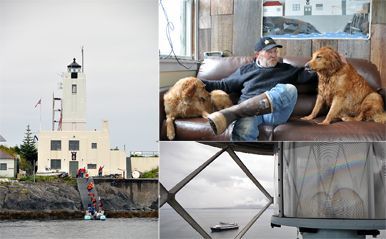
Dogs, people, boats, small ships: they all show a gumption, a courage to face a land that requires vigilance, a large state with small towns -- but with big hearts and friendly people.
The Andersons, who live in San Diego, are the resident travel & cruise columnists for Physician's Money Digest. Nancy is a former nursing educator, Eric a retired MD. The one-time president of the New Hampshire Academy of Family Practice, Eric is the only physician in the American Society of Travel Writers. He has also written five books, the last called The Man Who Cried Orange: Stories from a Doctor's Life.




